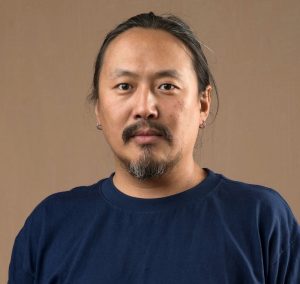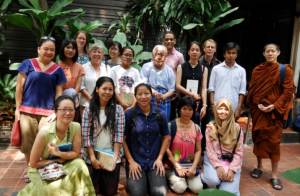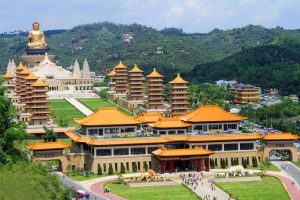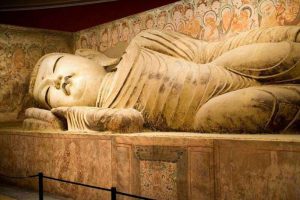The esteemed Tibetan Buddhist teacher and Dzogchen adept Chökyi Nyima Rinpoche marked the birth, enlightenment and Mahaparinirvana of Shakyamuni Buddha this month by leading the first-phase inauguration of a new monastery, Pal Thubten Shedrub Ling, in Lumbini, Nepal, the birthplace of the Buddha. The new shedra has been founded to support a monastic community at the site of the Buddha’s birth and to extend a welcome to the hundreds of thousands of international pilgrims who visit the sacred site annually.
Rinpoche presided over the consecration ceremony on 23 May for Pal Thubten Shedrub Ling, also known as the Thousand Buddha Temple. The celebratory event began in the early morning at the Maya Devi Temple, which marks the site of the Buddha’s birth. Male and female monastics from Ka-Nying Shedrub Ling monastery and Nagi Gompa, as well as staff, students, and alumni of Rinpoche’s Rangjung Yeshe Institute in Kathmandu, along with devotees and well-wishers from all over the world proceed in a procession to the new temple, carrying buddha statues and volumes of the collected words of the Buddha.
Rinpoche, with Tulku Urgyen Yangsi Rinpoche and Phagchok Rinpoche at his side, presided over the cleansing and consecration. The revelation of the three central Buddha images was graciously attended by the prime minister of Nepal, Pushpa Kamal Dahal, who expressed his deep appreciation and extended his warmest wishes.


Chökyi Nyima Rinpoche graciously shared his insights with BDG today, in the wake of this historic event.
“In Buddhism there are stages of faith that begin with inspired faith, then aspiring faith, and then the faith of confidence or the faith of trust, and finally changeless faith,” Rinpoche observed. “Inspired faith is when one stands face-to-face with something beautiful and inspiring; there’s just an immediate sense of joy, of deep appreciation of what one beholds. The mind is just taken by witnessing something so beautiful and delightful. That experience can then also lead to a wish to approach the qualities of what one has just witnessed; to become increasingly able to experience what lays behind that manifestation—so that is aspiring faith.
“On the basis of this, one can then study and contemplate to a deeper extent and experience the faith of confidence that one has understood the reasons for the way the Dharma is. Finally, when taking to heart what one has learned and come to understand, come to trust in, without any doubts, through genuine and immediate experience with the nature of the teachings, one will then gain changeless and unshakeable faith.
“Generally in Buddhism, there’s a distinction between following the teachings based on faith and following the teachings based on reasoning. In general, religion is based on faith, and in Buddhism this is also a very important factor: to have faith, in the right way.
“And what does it mean to have faith and trust as a Buddhist? Basically, it means to have a clear understanding of cause and effect, and the existence of past and future lives, how to make informed choices about what to do and what not to do, and to be confident in that knowledge; in other words, cultivating virtue and giving up negative actions. Doing this with confidence is following the teachings based on faith.
“And what does it then mean to do what is virtuous and give up what is unwholesome? This really comes down to doing things that are beneficial for others, while refraining from harming others. . . . To do this in a continuous way, and with confidence, is to follow the teachings with faith.
“But it is also possible to follow the teachings based on inquiry, going beyond the immediate accepting and rejecting actions of body, speech, and mind to also investigate the teachings in depth and come to increasingly understand, with the help of analysis of the texts combined with reasoning, and thereby become free from doubt with respect to teachings.
“And so one will thereby grow through the stages of faith . . . and finally as one comes to increasingly know and understand . . . this becomes the basis for contemplative practice, and with that, as experience begins to dawn, one steps into the fourth dimension of faith, which is the faith beyond change.
“Acknowledging these states provides the basis for understanding why Pal Thubten Shedrub Ling was built: in order to provide for those who need the teachings, and to create an environment in which this unfolding of faith can take place!”

Following the first phase consecration and cleansing ritual for this ambitious project, which was initiated in September 2011, Chökyi Nyima Rinpoche and the monastic community devoted themselves to reciting the collected words of the Buddha (Kangyur Dakdrok).
On the day following Saga Dawa Duchen, Rinpoche generously gave his first teaching in the main shrine hall, seated directly in front of the three newly consecrated golden statues of the Buddhas of the past, present, and future, as well as the statues of the 1,002 buddhas of the Good Eon. Rinpoche performed a refuge ceremony for the Rangjung Yeshe Institute participants, who hailed from Austria, Bhutan, China, Denmark, India, Nepal, Mexico, Russia, Thailand, the UK, and the US.
The consecratory program was brought to conclusion by the nuns of Nagi Gompa, who practiced the Treasury of Blessings, Offerings to the Sixteen Elders, the Concise Daily Practice, Sang Offering, and the liturgy of the Fourfold Mandala Offering to Tara.

“It is our sincere wish that this majestic temple be a sanctuary for Buddhist practitioners of all traditions, as well as a source of joy and peace for all who visit—now and for generations to come,” Rinpoche emphasized in an official announcement published by Ka-Nying Shedrub Ling in April. “Lumbini, the birthplace of the Buddha, is a UNESCO World Heritage Site that belongs to all of us.
“Everyone is welcome, Buddhists and non-Buddhists alike, to visit the temple and enjoy the beautiful and peaceful environment of the flower gardens outside, and the extraordinary artwork of the sacred statues and intricate wall paintings inside. May the Thousand Buddha Temple be an oasis of perfect tranquility, radiating peace, happiness, and well-being throughout all worlds!”

Saga Dawa (Skt: Vaishakha), the fourth month in the Tibetan lunar calendar, is the most important Buddhist religious and cultural event of the year. The name is derived from the clan name of Shakyamuni Buddha. The occasion is also known in Tibetan as Bumgyur Dawa, “the 100,000-multiplying month,” as karma from all skillful and unskillful actions is believed to be multiplied 100,000 times. This year, Saga Dawa runs from 12 May–10 June, with Saga Dawa Duchen, the single most important day of the year for Tibetan Buddhists, commemorating the birth, enlightenment, and final passing into parinirvana of Shakyamuni Buddha, falling on 26 May, the full moon day. The occasion is also known around the world as Buddha Purnima and Vesak in other Buddhist traditions and following different calendars.
See more
The Thousand Buddha Temple: Pal Thubten Shedrub Ling
Shedrub
DharmaSun
Rangjung Yeshe Institute
Related news reports from BDG
Dharma House Lisbon to Open in April with Inaugural Teaching from Khenpo Pema Namgyal
84000 Announces Online Teaching with Chokyi Nyima Rinpoche on 1 August
Live-streamed Concert for Buddhist Monastery and Nunnery in Nepal to Feature Norah Jones, Richard Gere, Laurie Anderson, and More
Related features from BDG
Clearing the Path to Compassion: A Conversation with Chökyi Nyima Rinpoche
Bodhicitta and the Buddhadharma: An Interview with His Holiness the 41st Sakya Trizin
Buddhism in the Hidden Valley, Part 1: An Ancient Heritage in Tsum
Licchavi House, a Refuge for Art, Culture, and the Buddhadharma in Kathmandu














It’s heartening to see Chökyi Nyima Rinpoche mark Vesak with the first-phase consecration of the new Pal Thubten Shedrub Ling monastery in Lumbini. This significant event not only honors the birth, enlightenment, and Mahaparinirvana of Shakyamuni Buddha but also brings a new sanctuary for monastic practice and international pilgrims to this sacred site. The emphasis on faith and reasoning in Buddhism, as beautifully articulated by Rinpoche, underscores the importance of both devotional and intellectual approaches to the Dharma. The establishment of this monastery promises to be a beacon of peace, wisdom, and compassion for generations to come. May it truly be an oasis of tranquility and joy for all who visit.